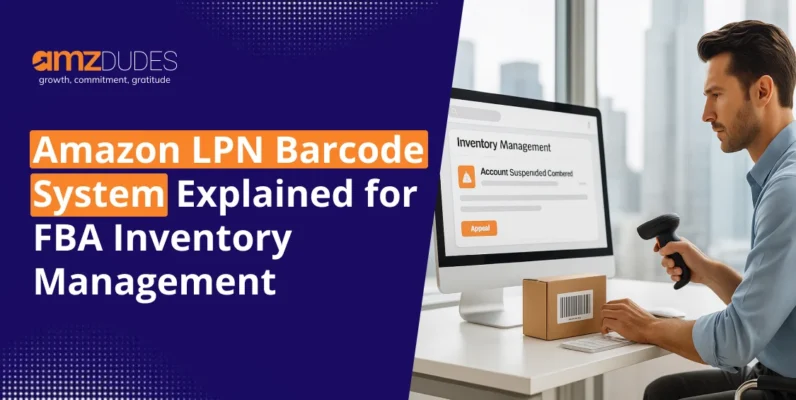Amazon Rufus AI is another groundbreaking upgrade in the ecommerce landscape. It is a conversational, AI-driven assistant that helps shoppers get better results, faster. But here’s what matters to 3P sellers: Rufus doesn’t just surface listings based on keywords. It interprets your entire product detail pagesh including title, bullets, A+ content, reviews, and even videos to determine relevance.
Your listings are no longer just for humans. Rufus reads them too. If your copy doesn’t clearly communicate benefits, if your keywords are hidden deep in the backend, or if your A+ content is just filler, you won’t be suggested.
Sellers who adapt quickly and align content and PPC with what Rufus favors will win visibility, clicks, and conversions.
Let’s talk strategy.
The Opportunity: Where 3P Sellers Are Losing Ground
You’ve probably experienced at least one of the challenges as a 3P seller; a dip in organic rank, keywords not converting like they used to, or a competitor climbing the ranks without dropping price. Chances are, they’ve already begun optimizing for Rufus.
Here’s what’s changing:
- Keywords alone don’t cut it anymore. Rufus evaluates overall content relevance.
- Generic bullets are filtered out. AI understands meaning and phrasing.
- Weak A+ content that looks nice but lacks value won’t help rankings.
- PPC can no longer compensate for poor content.
If your listings still follow outdated structures like keyword-stuffed titles, shallow bullets, and minimal A+ content, Rufus will pass you over.
Quick FAQQ. Why is Amazon’s AI called Rufus?
A. Rufus was the name of a Welsh Corgi who once was a familiar and beloved presence at Amazon’s office.
Q. What is Amazon Rufus AI?
A. A built-in AI assistant that helps shoppers find products by answering their questions in real-time.
Aligning Listing Structure with Rufus AI
1. Front-Load Value in Your Title and Bullets
Rufus focuses on natural language and intent, not just keyword matches. This means both placement and phrasing matter more now.
To show what Rufus AI Amazon prefers, compare these two real examples of different approaches to Amazon product listings optimization. One is structured to highlight buyer benefits and natural phrasing. The other is cluttered, keyword-stuffed, and lacks clear intent.
| Image 1 | Image 2 |
Image 1:
Buyer-focused, benefit-led structure
Clean formatting, easy to scan
Natural language that supports voice-style queries
Aligned with what Rufus AI understands as intent-rich content
Image 2:
Lists features without context or benefit
Hard to read due to dense formatting
Keyword-heavy but lacks natural phrasing
Unclear value for shopper, reduces relevance for AI search
Quick Checklist:
- Listing title includes keyword, product type, and key benefit
- Highlights the main problem your product solves
- Emphasizes what makes your product different
- Includes a real-life use-case or customer result
- Includes specs, compatibility, or use case
- Reinforces guarantee, support, or added value
2. Optimize A+ Content for Buyer Intent Signals
Rufus uses A+ content to understand product relevance. It is no longer just about visual branding. The words you use here count toward search matching.
Important Tips:
- Add comparison charts with clearly labeled benefits.
- Use headers that reflect search phrasing and common buyer questions.
- Echo your key differentiators in plain language, without overusing keywords.
Shoppers ask Rufus things like “What are denim trends for women?” If your A+ doesn’t connect clearly to that intent, you will be skipped, even if your product fits.
Action Steps:
- Rewrite module headers using natural phrasing aligned with search queries
- Add a lifestyle image with short text overlay summarizing three main benefits
- Create a comparison chart that lists target users and use-cases
3. Sync Your PPC Strategy with Amazon Listing Optimization
Rufus rewards relevance, and high-performing PPC campaigns give early signals that your listing is worth showing. If your ads promise one thing but your listing shows another, performance drops and so does visibility, making it essential to sync your PPC data with your listing optimization on Amazon.
High-performing ads help validate what your listing should say. Amazon listing optimization AI favors product pages that match what shoppers are actively clicking and converting on.
Here’s how to align PPC with content:
Use PPC to Shape Your Listing Content
- Review which search terms convert best in Sponsored Products and Brands ads.
- Integrate top-performing phrases into bullet points, A+ content, and title
- Avoid using ad copy that isn’t reflected on your product detail page
Watch for Mismatched Performance Signals
- High clicks, low conversion? Your listing is not deliver on the ad’s promise
- Low clicks? Your ad may not match what your listing emphasizes
4. Improve Infographics With Text AI Understands
Rufus reads the text within your images. Infographics and overlays aren’t just for shoppers anymore. They help AI understand your product too.
What to include:
- Phrases that describe use-cases like “For Long-Distance Commuters”
- Benefits written in plain English like “Keeps Skin Hydrated All Day”
- Comparisons like Before vs After or Brand X vs You
Suggested Image Types:
- Infographic showing key benefits
- How-to image with 3 simple steps
- “Who it’s for” breakdown by audience type
- Lifestyle use-case image with brief description
5. Structure Copy for Long-Tail Search and AI Queries
Rufus is trained on real customer queries. If your product copy mirrors how people actually search, your AI-friendly Amazon listings are more likely to rank in voice queries and detailed searches.
Examples of structured phrases that work:
- “Works with iPhone 13 through 15”
- “Safe for use on sensitive or eczema-prone skin”
- “Helps with post-workout muscle recovery”
These sentences are natural, helpful, and aligned with what customers type or speak when searching.
Common Mistakes 3P Sellers Make (And How to Avoid Them)
| Mistake | Fix |
| Bullets list only specs | Turn specs into benefits. Example: “Stainless steel” → “Rust-free, long-lasting use” |
| A+ content is all visuals | Add clear headers and benefit text that answers buyer questions |
| Ad copy doesn’t match listing | Make sure keywords and phrases from ads also appear in your bullets and A+ |
| Ignoring PPC search term data | Use converting search terms from ads in your listing content |
| Writing for bots, not buyers | Use natural language and highlight real use-cases, not just keywords |
Final Thoughts: Don’t Let Rufus Push You Down the Page
Rufus has changed the role of AI for Amazon listings. Your product page now needs to perform on every front. That means your content must be keyword-aligned, benefit-focused, and structured to match real shopper intent.
You don’t need a full overhaul. You need a smarter system that brings together PPC, SEO, content, and performance data.
Need Help Making the Shift?
At AMZDudes, we work with serious brands ready to grow through better strategy. Our systems align your content, ad performance, and brand voice in a way that helps you rise organically and profitably.
Our services include:
- SEO-optimized listings designed for AI Amazon listings and organic ranking
- Ad campaign management that turns shopper behavior into high-converting strategy
- Inventory management systems that reduce stockouts and boost sales velocity
- Full account management to streamline operations and maximize marketplace performance




